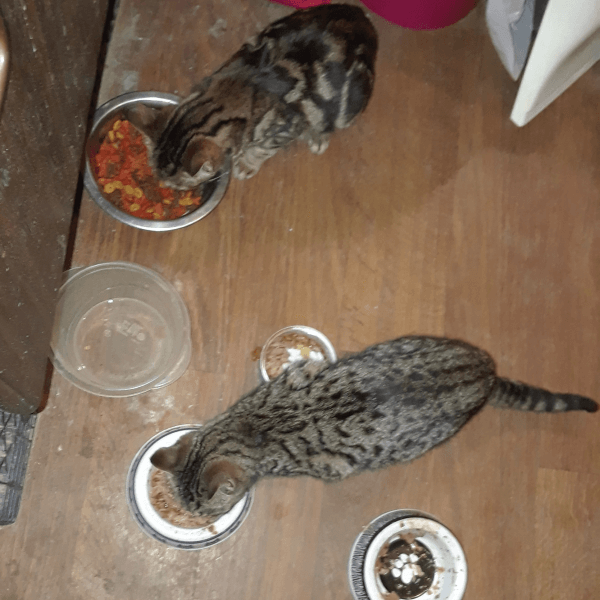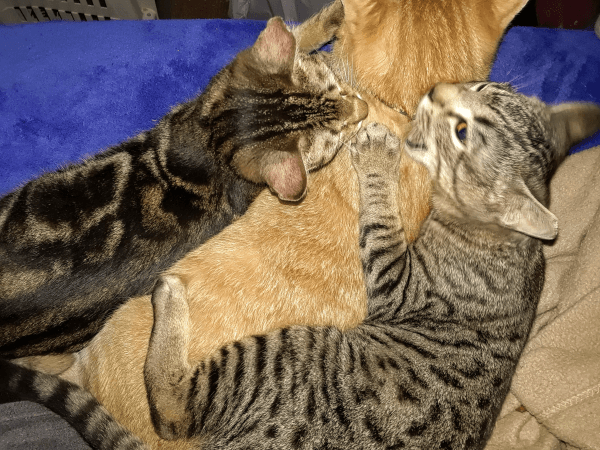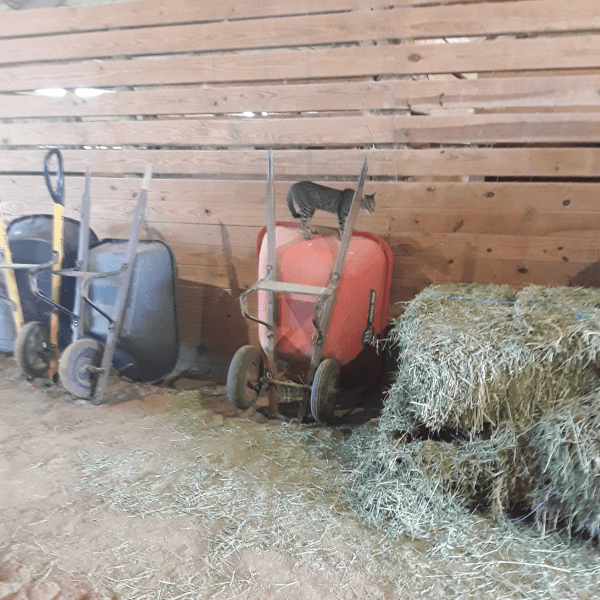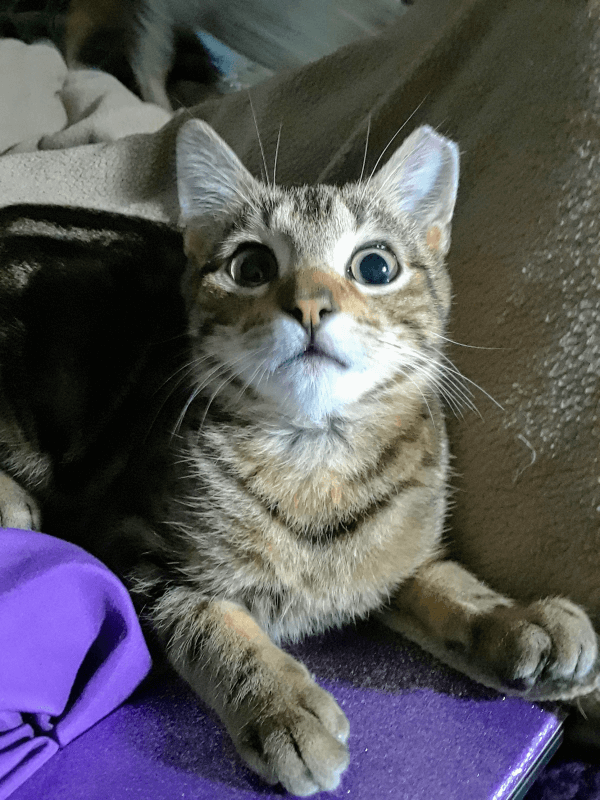Hey, cat lovers! Ready to meet Tweety, another one of my kitties?
Tweety’s story is a little bittersweet, unfortunately. I love this boy, though. Hopefully, you will too!

The Beginning
Tweety and four other teenage kittens were found in an abandoned colony of cats a few towns over. Not a lot is known about the situation, but I’ll list the bare facts.
A very unwell woman and her family started a nearly hoarding situation. They decided to ‘rescue’ a bunch of cats, as well as, oddly, raccoons and other injured wildlife. The wildlife had been kept in cages in the house. The cats may have been at some point, but they had been released outdoors. All of them, unfixed.
This mentally unwell woman and her family’s home was foreclosed on by the bank. They moved. But abandoned over 60 cats when they left. Animal control for the area got involved and asked for help from the local feral cat group in Lafayette, Louisiana, to get them all fixed before relocating them to a rice field or something.
All the cats were trapped and fixed. The nonprofit called on a few of us in a desperate attempt to find barn homes for some of these cats, most of whom acted feral. The rice field idea wasn’t a great solution as there would be no caretaker or acclimation period. Six barn people responded that first weekend. I took in 6 trapped feral adults. I purposely chose the scared and suspected feral ones.
There was just one problem: Five feral kittens, maybe too old to be socialized.
All of them were tabbies. All of them completely immobile with fear. It was estimated they were 4 months old (and that was wrong, after examinations, it was determined they were 5 months old and small).
This was the dilemma. Kittens that old, if completely feral, might not socialize easily. If they do socialize, they aren’t going to be comfortable with tons of people. TNR groups often offer kittens for adoption through PetSmart (thanks to PetSmart Charities). Would these kittens be socialized enough to handle that? They wouldn’t get adopted huddling in the corner of the cat enclosure.
I offered to try to socialize a couple of them. Choosing the two larger kittens, I took them home to socialize. I figured, even if I failed, I had a barn home for them.
The other three were kept at the office in an effort to socialize them there. This was not a success. Two of them were fixed and found barn homes. The last one, a pretty brown marbled tabby, was taken by a boy and his mother (who helped with trapping the colony).
Socializing Tweety and Marbles

I socialize kittens differently than the local feral cat group does, apparently. I’ve never had it fail, but I don’t usually deal with kittens in a shelter-like atmosphere or deal with cages.
In any case, I started working with Tweety and his brother, Marbles. I call them brothers, but we honestly do not know if they were separate litters or who their mothers were. Tweety is a gray and black tabby boy with spots instead of the normal amount of stripes. Marbles is a brown/gold marbled tabby and oh-so-pretty!
These two feral kittens, like the other three, were very ‘different. I’ve socialized ferals before this and these guys didn’t act normal at all. When terrified, they cowered and hid, even when being pet. They would get tenser and tenser but would refuse to move. They jumped when pet and looked back as if trying to see what I was doing, so they definitely weren’t socialized.
I was told the three at the rescue would be left in a room with the cage door open and they wouldn’t even leave it. They simply cowered in the corner of the cage. The entire time. They didn’t play when unsupervised. They didn’t explore the area. Nothing but eat, use a litter box, and stay cowering and terrified in a cat bed or corner of the cage.
For the first day, I simply left my two new foster kittens to hide and settle in. This was the time for them to get used to the cats and me, without being bothered. My place is like a studio, so I was able to supervise this all from one small room. They had places to hide and feel safe if needed.
The first time they saw my cat, Buddy, they immediately greeted him like he was their mama! They actually started to meow at him and bite the fur around his neck. Buddy, of course, was completely weirded out by this and tried to escape mobbing by kittens.
Other than really young kittens, I’ve never seen a cat meow at another cat. Cats use some vocalization with each other, such as hisses, growls, yips, and chirps, of course. Cats also use body language and scent to communicate, as well. But an adult cat doesn’t meow at other cats. You can check out why cats meow here.
Kittens will meow for their mama when hungry or scared or alone. Mama cats usually make vocalizations back, but not usually meows. Cats use meows exclusively with humans after kittenhood. It is theorized that cats learned this behavior to get our attention. Their meows are similar in frequency to a baby’s cries, apparently.

In any case, Tweety and Marbles started meowing in greeting at Buddy, my orange tabby. Their meows are different from normal cats meows. There were a lot of high-pitched sounds and chirps happening as well. I started suspecting that they had Bengal or some other cat breed in their ancestry somewhere. With Marbles’ unique looks and their odd vocalizations? In fact, Tweety chirped so often I started calling him Tweety and it stuck!
I also quickly realized they don’t find direct stares and direct approaches threatening. They will do this to their foster siblings and completely freak the poor cats out when the feral boys were not being aggressive. They simply wanted to smell noses.
So I continued to work with Tweety and his brother. I’ll go over this process in more detail when I discuss kitten socialization.
The feral boys did get fixed, vaccinated, FeLV/FIV (Feline Leukemia and Feline Immunodeficiency Virus) combo tested, and microchipped at one point during our time together. While they were back at the rescue’s office, they reverted back to freezing and cowering. Marbles at one point gave a warning bite, which broke no skin (thankfully).
This evaluation clearly failed and I’d had them a month.


Of course, I took the boys back! I wasn’t going to give up! So I continued to work on them. I hoped they could be adopted straight from me to their new home. It was slow going, but I got both completely tame. They can be picked up for a moment, even. Tweety actually flexes his paws when I pick him up as if kneading my arm and purrs now. They liked being pet. They started becoming vocal with humans.
Unfortunately, they still didn’t trust other people. Both former ferals are no longer terrified of people, luckily. They just refuse their affection by leaving. They would not do well in a shelter setting. I don’t think they ever will.
They hated being indoors, too.
So I made the decision to keep them as barn cats. I’m uncertain they would acclimate to anyone else and having grown up feral. I started letting them into the barns after a couple of months, they started following me around the barns, too!

The Cat Named Tweety
Tweety is estimated to be about two-and-a-half years old now. He doesn’t chirp as often, but he still meows oddly. He also grew. A LOT. He’s now a very lean, long cat who is all legs!
Tweety eats wet food like it is going to disappear before he finishes. He just loves it. He’ll eat dry food if it is necessary, but he definitely prefers wet food. Not pate, however. He loves cat treats. And cat toys? He chases a laser light and slides around the hardwood floors. Catnip, however, doesn’t affect him at all. He does like other toys as well!
It’s hard to believe he was so terrified at first because he is not afraid anymore. He doesn’t run or hide scared. He doesn’t hide from people. In fact, he has NO fear. No fear of cars, horses, people around the barn. Tweety just refuses to let them touch him.
He has turned into a bit of a bully with other cats, though. Because he keeps freaking them out by being so direct, he’s learned chasing them is fun. It escalates from there. Silly kitty.
Tweety and Buddy!
Want a video of Tweety? We have one! He joined me and Buddy walking one hot-as-crap afternoon!
Caring for Community Cats is Sad, Too

Unfortunately, two months ago, Marbles disappeared one morning. I do not believe that he would purposely take off, despite his feral background as he was bonded strongly to my cat, Buddy, and his brother, Tweety. He’s microchipped though and we believe he got accidentally transported on a horse trailer.
I have a lost post on Facebook. I’m still searching the shelters and the lost and found pet groups and classifieds near me.
Tweety was clinging to me a bit more after his brother went missing. But he’s adjusted okay now.
Tweety isn’t alone, at least. I also do not wish to give him up, especially after all this.
Leave a comment below telling Tweety how handsome he is!
Lovies!

First off I love what you are doing with these rescue animals. Tweety sounds amazing and I know he’s now in a loving situation. My dad would also rescue strays, we still have 11 cats we are trying to find homes but they got to be adults before they could be given away and now nobody wants them. We give them plenty of love and each is a challenge but all are fine cats. Thank you for your labor of love.
Thanks so much for your kind words! It definitely is harder to rehome adults, but it is possible to be done. I am still planning on trying with most of my fosters. Tweety, though, he is a special case since his socialization with other people isn’t so great.
Rochelle took in six feral cats, kept three at the office, and took two home. Two of the three at the office became barn cats and one of the three office cats a boy and his mother adopted. Then where is the sixth cat?
I’m scared to ask. Where is the sixth cat?
Thanks for sharing this article! It really is bittersweet but most importantly, Tweety has now loving mom and life he affords in terms of treatment and circumstances. In my place, the woman described in your story would not keep any animals or if she would even buy a cat, one phone call and it would be rescued. However, things are not on that good level everywhere and I really appreciate people like you giving great friends of us like Tweety, a new change! ps; Tweety is actually a nice name.
Aww, thanks so much. I’m glad you liked his name. I’ll have to be sure I included WHY he was named Tweety at first. He was always chirping at stuff, it was funny.
Thanks so much for coming by!
We had a lot of feral cats in our neighborhood and we had them trapped. They were taken to a shelter and adopted out. Our boy cat was a rescue and he is an amazing cat. We also have a Tabby named is Pebbles. But I picked her out of a litter when she was 8 weeks old. I think it is great all that you do for cats. The world needs more cat lovers like you!
Thanks for the compliment. If you had a lot of cats in your neighborhood that the shelter was able to adopt out, they likely weren’t feral. Otherwise, they would have been fixed and returned to the area OR euthanized, unfortunately. Hopefully, these cats found excellent homes! Thanks again!
Nice post, Rochelle. At least the mentally ill lady’s heart was in the right place, but it is not an uncommon problem in our society. What is hard is animal shelters struggling to stay financially viable looking after these furry discarded critters. This seems to be an animal type few days for me as I stumbled across another blog post yesterday about chickens. Which reminded me about an issue we had in my local area a couple of years ago.
Sometime back in the day someone (it was assumed), had discarded some chickens in bushland at a small lagoon near a popular picnic area, and over the years it went from a couple of roosters to a large number of roosters. Of course, some local residents got sick of being woken at 4 am by lots and lots of crowing, and had called on the local authorities to “do something.”
As well as lots of “feral” roosters there was also a large number of “feral” domestic ducks. The local authority had no idea how to approach the problem, as there was another side who didn’t want the “uniqueness” of the area changed, as the roosters weren’t people friendly, and never really bothered anyone having lunch at the park, unlike the ducks.
So, the local authority eventually played the “healthy and safety” card, and they had a couple of people (in hi-vis), do a preliminary “study” before removal of the domestic “wildlife”. This “study” created another problem because they found that the bushland was also home to a “community” of feral cats!
Obviously these cats preferred fresh chicken rather than chicken out of a tin. Anyway, the local autorities claim they were successful because they got “all” the hens. There are still roosters around the lagoon but with no hens, they are expected to disappear. Some cats were unfortunate and were lured into traps. So a once thriving “feral” community has been dramatically downsized.
All cats are attractive I think, their hypnotic stare and tail movements give some indication of their mood. As well, some do actually try to “talk” I believe anyway. I have a daughter called Joanne. We had a cat who often would call out (what sounded to us like Joanne), he never stopped doing it and although never perfect it was close. This was of course in addition to his normal cat “vocabulary”.
They are smart critters, easy to become attached to, hard to give them up, and sad when their time is up. I hope your cat goes to a good home if not, then you will still have the pleasure of their company. At the end of the day, they don’t ask for much.
Michael
Aww, thanks so much!
That’s quite the crazy story!!
What’s weird is I’ve never seen cats go after chickens before. They’re usually way too big for a cat to handle. Little baby chicks, that would be possible. But cats are solitary hunters, it might have been interesting to see. If he was hungry enough!
You’re right that there is just something amazing about cats. If Tweety never finds a home, I’ll end up with a very special boy.
I wish I could keep them all, but unfortunately, if I did that, I wouldn’t be able to help any more cats!
Thanks again for coming by!
I could use all the advice you can give. I have a. approx.30 some -odd cats/kittens. I started with one & unfortunate situations happened with most of them & i wound up adopting them. I know each ones individual personalities & need 2 start getting them fixed. Its costing me well over 500.00 a month & sometimes my sanity.They are outdoor mostly but also acclimated to indoor/ cat box. I will be reading your advice. Thank you for the insight
Tanya Rice.?
Hi, Tanya,
Here’s what I did when I first realized the cat issue and set about doing something about it with absolutely NO knowledge of my area, even.
I contacted a local rescue and asked them who deals with feral cats here locally as I was new to the area. They referred me to our local Trap-Neuter-Return group.
I emailed them and told them the situation and I was discussing how I could go about getting them all fixed when I couldn’t afford to do ALL of them at once. She offered me lower prices for their surgeries and explained how it all works, etc. Having 30 of them, you could likely get help from a rescue or similar nonprofit getting them fixed. Our TNR group also takes in kittens from colonies that are getting fixed to find them homes, if they’re young enough to be acclimated to indoor pet life. That service right there might help you if they take all the kittens to fix, vaccinate, and microchip for their adoption program.
I have a list of Barn Cat Programs by state on the site, that might help you find a TNR group near you. It can be found: https://barncatlady.com/working-cat-programs-us/.
Another suggestion would be to find homes for some of the friendly cats to indoor pets after they’re fixed. Just keep the cats that are too feral or unsocialized in your colony. This will also reduce the number of cats that you have to feed. And it’s also a part of TNR.
I hope that helps!
Tweety is such a cute and handsome boy! Lots of love to Tweety, and thank you so much for what you do 🙂
Thank you! He really is!
And what I do is not much, but it makes a huge difference to the cats I save. Sometimes that’s enough.
Thanks for visiting!